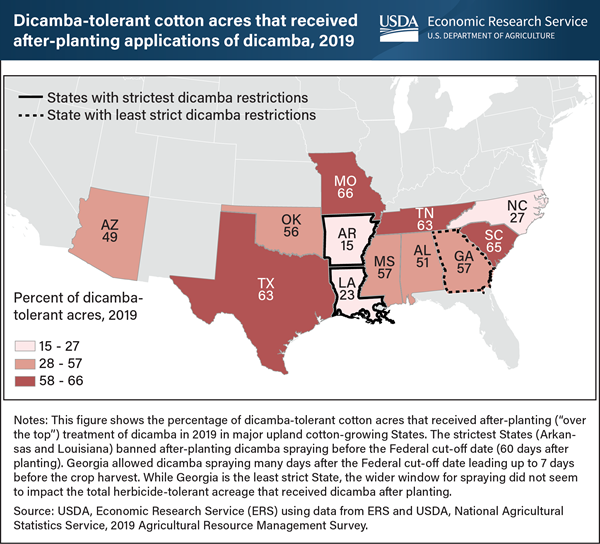[ad_1]
Dicamba is a commonly used herbicide for the control of annual and perennial broadleaf weeds. Federal and state restrictions on the use of dicamba can influence a farmer’s decision to adopt genetically modified dicamba-tolerant (DT) seeds. In 2019, for example, federal restrictions limited the application of dicamba to cotton fields from one hour after sunrise to two hours before sunset, limited applications to 60 days after planting. cotton and demanded that fields in areas with endangered plant species maintain buffer zones on all. sides of the field. Different states have imposed additional restrictions or extensions for the application of dicamba. For example, Georgia, Oklahoma and Texas were among the states that extended the window to spray dicamba further into the growing season from the 60 days allowed after planting by granting their farmers records of. special local needs, which was allowed at the time. Data from the 2019 USDA Agricultural Resource Management Survey shows that in states with earlier dicamba deadlines, less dicamba was applied after planting during the growing season. In Arkansas and Louisiana, where cut-off dates occur at the start of the growing season, 16 percent and 23 percent, respectively, acres of DT cotton were sprayed with dicamba after planting in 2019. In contrast, the Georgia allows spraying with dicamba up to one week before harvest. , which can occur until December. About 57 percent of DT cotton acres received applications after planting dicamba in Georgia in 2019. In 2020, the United States Environmental Protection Agency instituted a single nationwide deadline. July 30. This graph appears in the Amber Waves data feature from July 2021., “The adoption of genetically modified dicamba-tolerant cottonseed is widespread in the United States. “
Download the graphic at higher resolution (2049 pixels by 1861, 295 dpi)
[ad_2]

